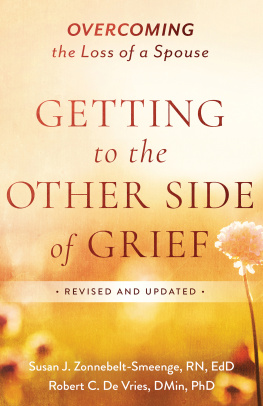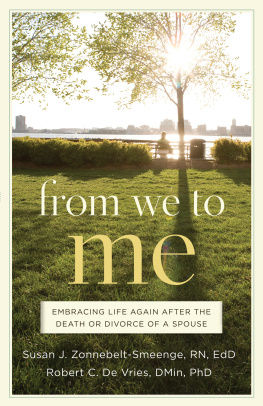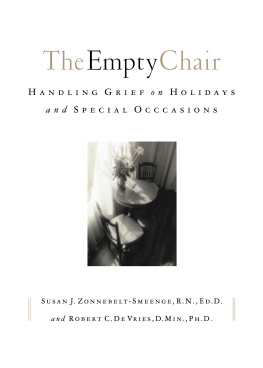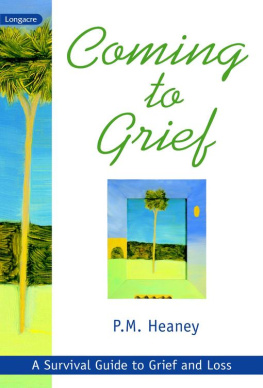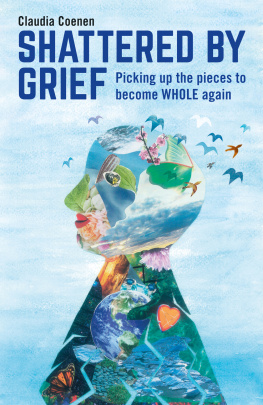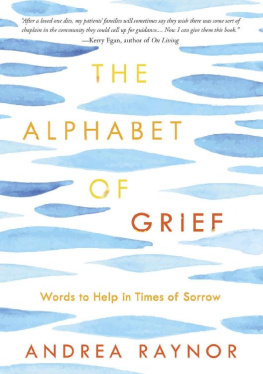1. Why Grieve?
2. What Is Grieving Like?
3. How Does Gender Impact My Grief?
4. Help! I Dont Want to Be Stuck in Grief!
5. Taking Charge of My Grief
6. Meeting the Challenges on My Journey
7. Dealing with My Childrens Grief
9. What Does the Other Side of Grief Look Like?
Epigraph

Mourning into Dancing
I should dance in Gods presence, they say,
though my heart is burdened with grief.
I should revel in Gods mercy, they say,
though my life is shattered with pain.
My partner has died.
This is the dark night of my soul.
Days and months press on.
Evenings and mornings lumber past.
My grief is great; my soul cries out,
Why me, O God? Why me?
Not you, my child. Not you.
Your spouse has died. Not you.
I gave you life. I gave you joy.
I can give again.
Sabbath.
Rest now, and begin again.
The sun burns brighterso slightly brighter.
The pain of the grave becomes the power of grace.
Step by step, God works his miracle.
You shall dance again, my child.
You shall dance again.
You, O God alone, can turn
My mourning into dancing.
r. devries

Preface to the Second Edition
Death is not unusual. People die every day. But each death is unique. Lives woven together are now torn apart.
The death of a spouse is especially difficult. Your partner has died. Feelings of abandonment or loss can overwhelm you. Perhaps some feelings of guilt or regret crash in, coupled with powerful feelings of anger, loneliness, and confusion.
This book is written for those who are grieving because of the intensely impacting death of a spouse. We are writing for the widowed of all ages, for those who are younger as well as mid-life and in retirement. The death of a spouse is very difficult regardless of age, although in every age group and phase of marriage there are different challenges to face. Thats why your age and length of marriage are both factors that make your grief unique.
We are writing for both widows and widowers. Gender plays a role in how you manage the grieving process because women and men often address the goals of grief in gender-specific ways. That is a significant reason we decided to collaborate on this book: to examine grief from both the male and female perspectives.
We also write out of our own professional and personal experiences. Susan is an RN and a licensed clinical psychologist who helps others face the issues of grief and loss regularly in her practice. Bob is an ordained minister and a seminary professor emeritus who deals with the issues of grief in the pastoral context. Both of us have experienced the death of a spouse. The writing of this book was in part motivated by our desire to share what we learned on our personal journeys toward wholeness as well as to impart our clinical and professional expertise. We do very much recognize the importance of credibility in that we have each walked the walk too, so this book is not only our professional insights but also the experiences of our challenging journeys through grief.
We found that our Christian beliefs combined with an accurate understanding of all that the grief journey entails following the death of a spouse provided us a helpful platform for dealing with our grief in a healthy manner. This does not imply, however, that persons from other backgrounds or no religious affiliation cannot benefit from what we say here. Death is common to all. Grieving a death is a natural consequence of loss when attachment has occurred, and what we discuss with you on these pages can helpno matter where you come from spirituallyas you are seeking to deal with your own grieving process.
Each chapter addresses specific issues of the grieving process from both the psychological and the spiritual perspectives; however, these two sections are kept separate. Susan is primarily responsible for The Psychologist Says sections that deal with healthy goals and behaviors for managing the grieving process. Bob is primarily responsible for The Pastor Says sections that deal with spiritual beliefs about your spouses death and your grief journey. In the chapter on gender differences, we have woven our personal stories of our grief journeys with a broader perspective of cultural similarities and differences of how men and women tend to look at the death of their spouse.

